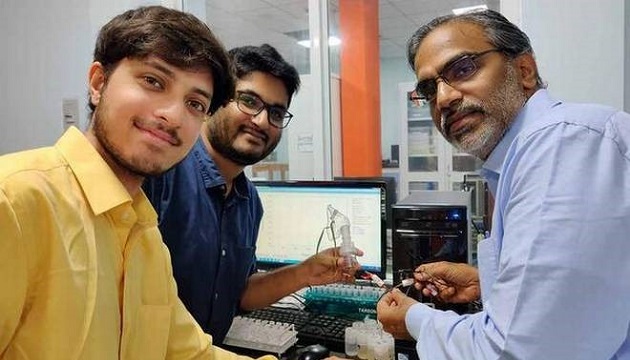A research team from IIT Madras’ Department of Chemistry, led by T. Pradeep has fabricated a nanofibre sensor, which is capable of sensing minute variations in relative humidity levels in the exhaled breath. The sensors are highly sensitive and can be integrated into wearable electronics and it potentially has applications like assessing calorie burn rate and human metabolism.
The sensor can also detect traces of ethanol and acetone, two major components present in the oral breath of alcoholics and diabetics, respectively.
Portable sensor
To make the sensor truly portable, the researchers are using the popular Arduino prototyping platform coupled with Bluetooth module for collecting data wirelessly.
“We initially tested the sensor performance using an Arduino Uno and we observed a good response. We intend to team up with other departments to recognise patterns by using machine learning and to develop mobile-friendly apps to monitor health,” says Professor Pradeep.
Quick response
The sensors have very quick response time of about one second and can detect a range of relative humidity from 0-95%. The sensor was found to have high stability. “Even after exposing the sensor to ambient conditions for a week, we still found the response time to be about one second and could match the breathing rates quite effectively,” said Sathvik Ajay Iyengar who was a short-term student with Professor Pradeep’s team and is one of the first authors of a paper published in the journal ACS Applied Electronic Materials.
The breath rate was measured for one-two hours prior to and after exercise. The heart rate is higher soon after exercise and this is reflected in higher breath rate. “We intend collecting breath rate over a period of few days to establish the relationship between heart and breath rate and metabolism,” said Pillalamarri Srikrishnarka from IIT Madras.
The nanofibre mat is fabricated by electrospinning poly (vinylidene fluoride) and reduced graphene oxide. Coating the mat with polyaniline turns the mat into a sensor.
The moisture in the breath reduces the resistance of the sensing material thereby allowing more current to flow. So when a fixed voltage (1-2 volts) is applied to the sensor, there is more current that is detected when the sensor comes in contact with moisture in the breath.
“In the presence of humidity, 100-1000 times more current can be detected using our sensor compared with other sensors,” said Iyengar. “So when the current measured is in nanoampere range when other sensors are used, we were able to measure it at microampere range using our sensor,” he added.
When there are traces of ethanol and acetone in the breath, the resistance of the sensor increases and conductivity reduces. Hence, there is a dip in the current measured from the baseline. “The reduction in conductivity is because of the absence of moisture — the hydrogen bond between the sensor and analyte (ethanol and acetone) is less likely to form,” said Srikrishnarka.
“Polyaniline is the major contributor of current conduction, and reduced graphene oxide complements it. The combination of polyaniline coating and reduced graphene oxide allows higher current conduction,” said Srikrishnarka. “In the absence of reduced graphene oxide, polyaniline can still conduct current but at a significantly lower level. The reduced graphene oxide alone does not help conduct current.”
“The coating of the mat with polyaniline occurs in water and so can be scaled-up to get large-scale coatings. This process also makes it easier, quicker and relatively more eco-friendly than other commercial processes,” said Professor Pradeep. The nanofibre mat obtained is very thin and offers breathability. In order to integrate sensors like this into wearable electronics to monitor breath, resistance-free air flow is the key.
The team plans to take the work forward via startup initiatives.








